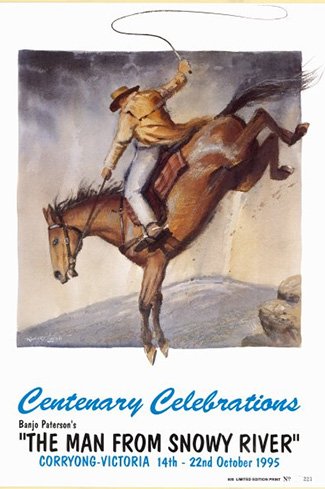Top 10 iconic Banjo Paterson bush ballads

AUSTRALIANS LOVE THAT Andrew Barton ‘Banjo’ Paterson (1864-1941) found romance in the tough and wiry characters of bush. And more than 100 years after the words were penned we find they still ring out across the nation. Some have even made it into outer space.
Here is a list of the top 10 most iconic Banjo Paterson ballads.
1. Waltzing Matilda, 1903
To many, this is the unofficial Aussie anthem, but the intended meaning of this ballad that describes the suicide of an itinerant sheep-stealing swagman to avoid capture, is debated to this day. Some say it was a political comment on the violent shearers’ strikes happening at the time, while a new book Waltzing Matilda: the true story argues it may have been about a love triangle happening in Paterson’s life when he wrote it.
Whichever the case, according to the National Film and Sound Archive it has been recorded over 600 times in just about every possible musical style. In 1983 the late country-and-western singer Slim Dusty’s rendition became the first song to be broadcast to Earth by astronauts.
Parts have been sung at six Olympic Games ceremonies dating back to 1956. The Seekers recorded it three times, and Slim played it at the closing ceremony of the Sydney 2000 Olympics. More recently, in 2008 world-famous Dutch violinist Andre Rieu played the tune to a singing Melbourne audience of more than 38,000 people.
2. Clancy of The Overflow, 1889
Published in 1889 in the Australian news magazine, The Bulletin, Clancy of The Overflow is a story about a city-dweller who meets a drover and proceeds to romanticise his outback life. It’s based on a letter Paterson received from Thomas Gerald Clancy which he replied to, only to receive the reply: “Clancy’s gone to Queensland droving and we don’t know where he are”.
3. The man from Snowy River, 1890
Clancy would feature briefly in Paterson’s poem, The man from Snowy River, which was published by The Bulletin the next year. It follows a mountainous horseback pursuit to recapture the colt of a prize-winning racehorse living with brumbies. One of the riders gallops across the Australian $10 note next to a picture of Paterson.
4. The man from Ironbark, 1892
This poem tells of a man who reacts badly to a practical joke sprung on him by a Sydney barber. In 2004 a representative of The Wilderness Society arrived at NSW’s Parliament House dressed as ‘The Ghost of the Man from Ironbark’, to campaign for the protection of the remaining Ironbark woodlands in New South Wales and Queensland.
5. Mulga Bill’s bicycle, 1896
The tongue-in-cheek story of Mulga Bill, a man who claimed he was an excellent cyclist only to crash, was published by The Sydney Mail. Mulga Bill was based on a man of the name of William Henry Lewis, who knew Paterson around Bourke, NSW, and who had bought a bicycle because it was an easier form of transport than his horse in a time of drought.
6. The Story of Mongrel Grey, 1896
This tale tells of a rickety old horse that learned how to swim. During an inland flash flood, he saves his master’s son. It was published in 1896 in the Australasian Pastoralists’ Review (1913-1977) and also in Paterson’s book Saltbush Bill, J.P. and Other Verses.
7. A bush christening, 1893
Banjo published this mischievous tale of a young lad who doesn’t want to be christened and ends up being named after a whisky in The Bulletin in 1893.
8. In the droving days, 1891
This sentimental work about a drover selling his faithful horse and reminiscing about their days on the land still speaks to people as mechanised transport and the cost of maintaining stock routes sees the very last of the drovers disappearing.
9. The last parade, 1902
Paterson wrote this sad ballad about war-weary horses after working as a correspondent during the Boer War in South Africa. It appeared in Paterson’s collection Rio Grande’s Last Race and Other Verses after his return home.
10. The Geebung Polo Club, 1893
A favourite for the comparison of the rough and ready Geebung Polo Club members and their wealthy city competitors ‘The Cuff and Collar Team’. Geebung is the indigenous name for a tough fruiting shrub (Persoonia sp.).
RELATED STORIES




